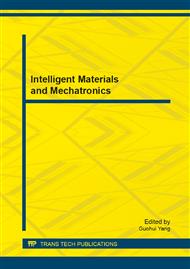[1]
R.M. Fand, The influence of acoustical vibrations on heat transfer by natural convection from a horizontal cylinder to water, Journal of Heat Transfer, Vol. 87, pp.309-310, (1965).
DOI: 10.1115/1.3689095
Google Scholar
[2]
K. W Li and J.D. Parker, Acoustical effects on free convective heat transfer from a horizontal Wire, Journal of Heat Transfer, Vol. 89, pp.277-278, (1967).
DOI: 10.1115/1.3614383
Google Scholar
[3]
K.A. Park and A.E. Bergles, Ultrasonic enhancement of saturated and subcooled pool boiling, International Journal of Heat and Mass transfer, Vol. 31, N°3, pp.664-667, (1998).
DOI: 10.1016/0017-9310(88)90049-x
Google Scholar
[4]
H. -Y. Kim, Y. i G. Kim, B. H. Kang, Enhancement of natural convection and pool boiling heat transfer via ultrasonic vibrations, International Journal of Heat and Mass Transfer, Vol. 47, pp.2831-2840, (2004).
DOI: 10.1016/j.ijheatmasstransfer.2003.11.033
Google Scholar
[5]
J. L. Ayala, A. Sridhar, D. Cuesta, Thermal Modeling and Analysis of 3D Multi-Processor Chip, Integration, the VLSI Journal, Vol. 43, pp.327-341, (2010).
DOI: 10.1016/j.vlsi.2010.06.002
Google Scholar
[6]
P. G. Del Valle, D. Atienza, Emulation-Based Transient Thermal Modeling of 2D/3D Systems-On-Chip with Active Cooling, Microelectronics Journal, Volume 42, Issue 4, April 2011, Pages 564-571, (2011).
DOI: 10.1016/j.mejo.2010.08.003
Google Scholar
[7]
F. Baffigi, C. Bartoli, Heat Transfer Enhancement from a Circular Cylinder to Distilled Water by Ultrasonic Waves: Preliminary Remarks, Proceedings of the ExHFT-7, 7th World Conference on Experimental Heat Transfer, Fluid Mechanics and Thermodynamics, 28 June-03 July, Krakow, Poland, (2009).
DOI: 10.1115/ihtc14-22773
Google Scholar
[8]
F. Baffigi, C. Bartoli, Heat Transfer Enhancement from a Circular Cylinder to Distilled Water by Ultrasonic Waves at Different Subcooling Degrees, IHTC14, International Heat Transfer Conference, Washington DC, USA, 8-13 August, (2010).
DOI: 10.1115/ihtc14-22773
Google Scholar
[9]
F. Baffigi, C. Bartoli, Effects of Ultrasounds on the Heat Transfer Enhancement from a Circular Cylinder to Distilled Water in Subcooled Boiling, Journal of Thermal Science and Engineering Applications, Vol. 3, Issue 1, (2011).
DOI: 10.1115/1.4003510
Google Scholar
[10]
F. Baffigi, C. Bartoli, Effects of Ultrasonic Waves on the Heat Transfer Enhancement in Subcooled Boiling, Experimental Thermal and Fluid Science, Vol. 35, Issue 3, (2011).
DOI: 10.1016/j.expthermflusci.2010.11.002
Google Scholar
[11]
F. Baffigi, C. Bartoli, Influence of the Ultrasounds on the Heat Transfer in Single Phase Free Convection and in Saturated Pool Boiling, Experimental Thermal and Fluid Science, Vol. 36, (2012).
DOI: 10.1016/j.expthermflusci.2011.07.012
Google Scholar
[12]
C. Bartoli, F. Baffigi, Use of Ultrasonic Waves In Subcooling Boiling, Applied Thermal Engineering Vol. 47, pp.95-110, (2012).
DOI: 10.1016/j.applthermaleng.2012.02.009
Google Scholar
[13]
R. J. Moffat, Describing uncertainties in experimental results, Experimental Thermal and Fluid Science Vol. 1, pp.3-17, (1988).
DOI: 10.1016/0894-1777(88)90043-x
Google Scholar
[14]
F. Kreith, Principles of Heat Transfer, Dun- Donnelley Publishing Corporation, New York, (1973).
Google Scholar
[15]
S.C. Hyman, C.F. Bonilla, S.W. Ehrlich, Heat Transfer to Liquid metals and Non-Metals at Horizontal Cylinder, AIChE Symposium on Heat Transfer, Atlantic City, pp.21-33, (1953).
Google Scholar
[16]
V.T. Morgan, The Overall Convective Heat Transfer from smooth Circular Cylinders, in T.F. Irvine and J. P. Hartnett, Eds., advances in Heat Transfer, Vol. 11, Academic Press, New York, pp.199-264, (1975).
DOI: 10.1016/s0065-2717(08)70075-3
Google Scholar


